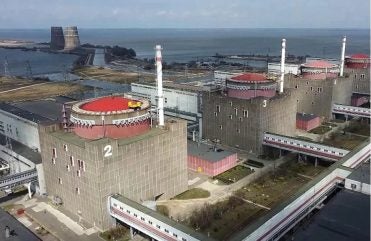
The International Atomic Energy Agency (IAEA) experts based at the Zaporizhia NPP (ZNPP) on 13 August paid a second visit to the plant’s cooling tower which ZNPP says was attacked on 11 August by Ukrainian drones. IAEA Director General Rafael Mariano Grossi said IAEA experts viewed evidence provided to the team that continues to indicate that the fire did not start at the base of the cooling tower.
Ukraine had alleged that the fires had been started by Russia burning tyres at the base of the tower. However, ZNPP Director, Yuriy Chernichuk said it is possible that the drone that attacked the station was carrying a flammable liquid. “By the speed with which the fire started, we can assume that there was something else – bottles of gasoline or napalm, because fire broke out very quickly and over a large area”. He added that the combat drone, “flew through the top into the space of the cooling tower and detonated” setting fire to steam traps made of plastic, which were completely burned out, and that the building and supporting structures were exposed to the fire.”
Following the IAEA’s first visit to the cooling tower on 12 August, the team reported observing burnt areas in the internal equipment higher up, near the water nozzle distribution level. “They also observed droplets of burnt plastic and fragments of fallen concrete distributed across the cold-water basin. The team assessed that these droplets were consistent with melted and fallen plastic mesh from the fire. Samples of the debris, including burnt and molten plastic, were collected. The lingering odour from the fire was assessed by the team and determined that in the absence of a sulphur smell, was more likely caused from burning plastic.” IAEA added: “Neither tyre nor drone remains were observed during the walkdown.” The Agency said: “The team has not been able to draw definitive conclusions on the basis of the findings and observations so far.”
During the second visit, the following day, IAEA reported that, due to safety reasons, “the team observed from ground level as ZNPP staff filmed and photographed the fire damage to the interior of the tower from the water nozzle distribution level, which is approximately 10 metres high.” The photographs and video footage were shown immediately to the team, which confirmed “extensive damage to the internal components at the water nozzle distribution level”.
From the photos and footage of the cooling tower’s interior, the team identified debris consistent with a significant fire and observed dark scorch marks across the interior of the concrete walls rising from the water nozzle distribution level. No foreign objects or materials were visible.
“The evidence gathered reinforces our conclusion that the main fire seems unlikely to be at the base of the cooling tower,” Grossi said. ZNPP informed the team that the impact of the fire on the structural integrity of cooling tower needs to be assessed and that there may be a need to dismantle it.
The team then requested access to the second of the two cooling towers at the plant in order to see inside the structure and identify similar materials and specifications which may have been present in the first cooling tower prior to the fire.
The IAEA’s response continued to be the source of widespread criticism from Russian officials for its failure to identify Ukraine’s responsibility for the attack.
ZNPP Communications Director Yevgenia Yashina in an interview with 360.ru noted that currently, there are four IAEA specialists at the NPP site who monitor the work and make certain requests. Their task is “to record what is happening” but “not to comment”. She added: “They state the fact that there is shelling, shout that this should not happen, but no further assessments are taking place.”
The Deputy Permanent Representative of the Russian Federation to International Organisations in Vienna, Roman Ustinov, told Gazeta that the IAEA assessment following the visit to the cooling tower “did not meet the expectations” of the Russian side. He stressed that it does not contain anything “that would point to the Ukrainian side as the culprit”.
The Permanent Representative of the Russian Federation to the International Organisations in Vienna, Mikhail Ulyanov, said on his official Telegram channel that he had discussed the situation at ZNPP with Grossi. “I met with IAEA Director General Rafael Grossi to discuss the situation at Zaporizhia NPP. In particular, I stressed the need for the IAEA to publicly name those responsible for regular attacks on the station.” He added that “silence on this issue only encourages new strikes that endanger nuclear security”.






